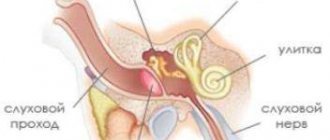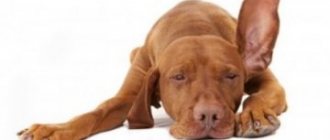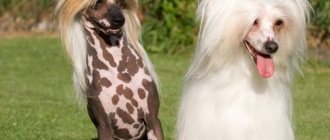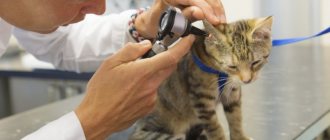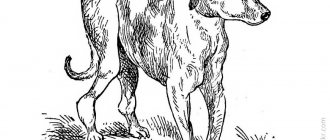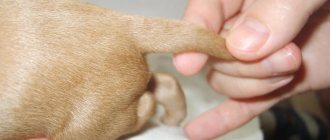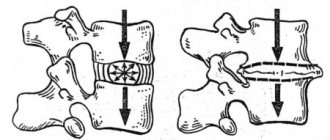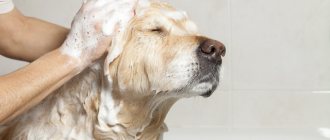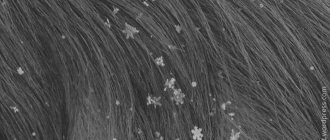A healthy dog is cheerful and alert, it eats well and enjoys walking, running and playing with its owner. If she begins to whine, shake her head, try to scratch her ear, lies indifferently in the corner and does not respond to the owner’s calls, and has lost her appetite even for treats, then these are sure signs of the dog’s ill health. Most likely, this condition causes otitis in dogs, from which representatives of fold-eared breeds suffer especially severely and often.
As in humans, otitis media in dogs has several types:
- external, which extends to the area from the auricle to the eardrum;
- middle, localized behind the eardrum. With inflammation of the middle ear, infection often occurs and severe inflammation occurs with the development of purulent otitis media;
- internal, often resulting from an advanced disease and threatening serious complications for the health and hearing of the animal.
In most cases, otitis in dogs, which can be treated at home after receiving instructions from a doctor, is caused by a bacterial infection or fungal infection.
Causes of ear inflammation
In dogs, otitis media develops as a result of the action of external factors on the body, or as a reaction to existing pathologies. The list of common reasons:
- Fur in the ears.
Large tufts of hair covering the ear canal impede air exchange and provoke increased secretion of earwax. Humidity and plaque create favorable conditions for the development of bacterial infections.
- Ear mite.
Otodectis, a frequently diagnosed pathology, the mite Otodectes cynotis feeds on sulfur and epithelium. Causes itching, redness, provokes scratching and secondary infection.
- Low immunity.
When the dog’s body’s defenses decrease, opportunistic microflora “raises its head.” Fungal and bacterial otitis develops.
- Neoplasms.
Papillomas and tumors in the ear canal can completely block it, disrupting air exchange. When they are damaged (inflammation, blood), a secondary bacterial infection or fungi occurs. Secondary tumors appear as a consequence of prolonged inflammation in the ear.
- Blocking the ear canal.
Occurs in folded dogs (chow-chow, sharpei). Overgrown folds and cartilage completely cover the ears, disrupting air exchange, causing weeping and severe inflammation.
- Allergic reactions.
Food and atopic allergic reactions are accompanied by increased secretion of sulfur and increased activity of opportunistic microflora. They end in a strong inflammatory reaction, otitis media.
- Foreign body.
Any object (mote, grass seeds, small toys, etc.) causes inflammation due to impaired ventilation of the ear canal and increased production of sulfur.
- Water in the ears.
Getting dogs' ears wet is strictly prohibited. You cannot wash your pet without first placing cotton wool in the ear canals. Water gets in when the dog bathes in ponds. Stagnation of fluid in the ear canal is an excellent feeding ground for bacteria.
- Hormonal disorders.
Otitis media is a consequence of malfunction of the adrenal glands, reproductive organs, and thyroid gland. Dandruff, redness, swelling are visible on the ears, itching and severe inflammation begin.
- Sweets in the diet.
Dogs are not allowed sweets - this is a fact, despite the fact that some pets happily eat forbidden cookies, sweets, etc. Sugar changes the functioning of the intra-ear glands, provoking the production of sulfur with “impurities” of sweets. Discharge becomes an excellent field for the activity of fungi and bacteria.
It is important to establish the exact cause of the disease. This will help quickly get rid of inflammation and prevent relapse. Advanced otitis media easily spreads to the middle, inner ear and membranes of the brain.
In puppies
As a preventive measure, it is recommended to carefully monitor the health of dogs’ ears, their cleanliness, and increase immunity with the help of a balanced diet. After the walk, the ears are inspected and dirt and insects are removed.
This especially applies to puppies, who are more active and run around in bushes and tall grass during walks, where there may be dangerous insects.
Types of otitis
Knowing the types of disease is necessary to prescribe treatment. There is a basic treatment regimen, but the same drugs cannot be used to treat different types of disease.
There are:
- Outer. The inflammatory process develops from the beginning of the opening of the ear canal to the eardrum. It happens: idiopathic, primary, secondary.
- Otitis media in dogs. The pathological process involves the eardrum and facial nerve. Symptoms: tilting the head towards the diseased organ, sicca keratoconjunctivitis, pain when touched.
- Interior. The most difficult, unpredictable according to the forecast. Inflammation affects the structures of the labyrinth of the ear and spreads to the brain. Symptoms: impaired coordination of movements, dysfunction of the vestibular apparatus, frequent fluctuations of the eyeballs.
Verrucous otitis media
From inside the ear canal, due to pathological growth of tissue, growths, “warts,” are formed. Gradually they block the ear canal, making cleaning and any hygiene procedures impossible. With the accumulation of pus and sulfur, the course of the disease worsens. Verrucous (warty) otitis media is a consequence of untreated inflammation that began in the external auditory canal.
The onset of the disease is accompanied by redness of the skin, the amount of discharge (sulfur) increases. Next comes opportunistic microflora, which is usually found on the dog’s skin in a “dormant” state. The amount of exudate increases and inflammation intensifies. The difficulty in treatment lies in the structure of the ear canal. It is shaped like an inverted letter "L". The accumulation of exudate occurs in the horizontal branch, from where it is difficult to extract pus and sulfur.
Lack of treatment leads to pathological tissue growth, warts block the passage, purulent exudate remains inside and begins to dissolve the eardrum. There are signs of purulent otitis media in a dog. Inflammation spreads to all structures of the ear and reaches the meninges, surrounding tissues, parotid salivary glands, and abscesses develop.
Signs of verrucous otitis media include severe anxiety in the dog, it begins to fiddle with the sore ear, shakes its head, and sits tilted to the affected side. The smell is unpleasant, the purulent discharge intensifies, stains the surrounding fur, and sometimes splashes of exudate scatter to the sides.
Malassezia otitis media
Malassezia, fungal infection, yeast. Normally, the fungus Malassezia pachydermatis lives on the skin and mucous membranes of the dog. Their activity begins with high humidity, heat, decreased immunity, and damage to the dermis.
Another name is otomycosis, fungal otitis media, which can also be caused by fungi of the genus Candida. In any case, it is not contagious and cannot be transmitted to dogs or humans.
The reasons for the development of Malassezia otitis media are allergies, parasitic infections (as a complication of otodectosis), autoimmune processes, tumors, and injuries. Otomycosis is more often diagnosed in dogs with floppy ears due to poor ventilation of the ear canal, excess moisture, and diaper rash.
The disease is characterized by severe itching, redness and thickening of the dermis. The discharge is yellow-brown, moist, sticky.
It is impossible to cure fungal otitis without eliminating the underlying disease. Local antifungal agents are used for minor development of the disease; in complex cases, systemic agents are required.
Allergic otitis media
Externally, its symptoms will be similar to other types of the disease. But the reasons for its development lie in the influence of external factors. This could be industrial food, fleas, hygiene products, chemicals (air flavors, floor cleaners, etc.), cigarette smoke. Allergic otitis can be cured only by identifying and eliminating its cause; using only local agents to suppress inflammation is ineffective.
Bacterial otitis.
A consequence of exposure of a dog’s ears to staphylococcal, streptococcal infections, and sometimes viruses. It is characterized by swelling, the appearance of strong discharge and an unpleasant odor. Distinctive feature: the disease affects only one ear, but if left untreated it can spread to the second.
Diagnostics
If the owner notices that the dog has an inflamed ear, the question naturally arises: how to treat it. Modern veterinary capabilities make it possible to quickly and accurately determine the cause of otitis media. Only on the basis of laboratory tests is the causative agent of the disease identified, and the most suitable treatment regimens are selected. Trying to solve the problem yourself can cause complications, including deafness and inflammation of the meninges, and can also lead to the death of the animal. How and with what to treat otitis in a dog is decided by the veterinarian.
To identify the causes of the disease it is necessary:
- general and biochemical blood tests to detect infection;
- a cytological examination of ear discharge will detect a certain type of bacterial or fungal colonization or infection;
- Microscopic examination of a smear, skin particles, crusts will reveal parasites and other pathogens that affect the microflora.
In certain cases, additional diagnostics may be required to confirm the primary cause of otitis media: examination of the thyroid gland, skin biopsy. Your veterinarian may also suggest an allergen-free diet.
During the examination, it is important to pay attention to the presence of skin lesions on parts of the body, which, together with otitis, may be a consequence of the same disease.
To complete the clinical picture, the veterinarian may prescribe an x-ray or ultrasound examination, confirming or refuting the appearance of possible neoplasms. Of considerable importance for making a diagnosis are such details as nutrition, living environment and walking habits, past or chronic diseases, and injuries. You will need to remember when the symptoms of otitis media were first noticed in a puppy or adult dog. To clarify the dates of vaccinations and treatments against parasites, a veterinary passport of the pet is required!
General symptoms of the disease
Independently, at home, a breeder may suspect otitis media in a pet. But its type can be accurately determined only by visiting a veterinary clinic and conducting laboratory tests.
Symptoms of inflammation:
- damage to the dermis, crusts, scabs;
- itching, constant scratching of the ears;
- a lot of sulfur, pus, unpleasant odor;
- severe swelling of the skin, redness;
- the skin inside the ear feels hot to the touch;
- severe pain, the pet does not allow touching or examination;
- enlargement of the submandibular lymph nodes.
The protracted process affects the dog’s well-being; it becomes apathetic, depressed, and eats poorly.
Excess hair may be found in the ear canal; the hairs grow deep and need to be removed (plucked). There is no need to cut them, they will become thicker.
With ear mites, a black-brown, droplet coating collects on the inside of the ear, under which bleeding wounds open. The lesion usually affects both ears.
Bacterial, fungal otitis is accompanied by purulent discharge, local and general temperature rises. When prescribing antibiotics, it is necessary to culture the ear secretions on nutrient media. Using laboratory tests, it is possible to establish the sensitivity of microflora to antibacterial drugs.
When water gets into the ears, an inflammatory process develops; the exudate (transparent, serous, purulent) in this case will be much thinner than with other forms of otitis.
Allergic otitis media is accompanied by combined symptoms on other parts of the body: itching, urticaria, swelling, etc.
What is the difference?
Purulent otitis is an inflammatory disease affecting the outer, middle and inner ear. The deeper the disease penetrates, the more seriously the hearing system suffers, and the risk of partial or complete hearing loss increases.
Develops as a complication of an infectious, fungal or parasitic disease. It differs from other types of pathology in the release of pus with an unpleasant odor. The animal's condition instantly deteriorates, which manifests itself in the form of increased body temperature and vomiting.
First aid at home
If the discharge and inflammation are minor, it is permissible to clean the ear yourself. If there are severe lesions, tumors, or extensive purulent processes, it is almost impossible to treat the ears; the dog will be in pain. Light anesthesia and cleaning in a hospital setting are often required.
Procedure:
- Clean the ear with a special lotion, boric alcohol. You can take sea buckthorn oil or medications for the treatment of otitis media. It is recommended to use hydrogen peroxide (3%) for purulent otitis, just pour it in so that the maximum amount of exudate comes out with foam. But it unnecessarily dries out already inflamed skin.
- Clean out (remove) the exudate well.
- Place Otipax and Otinum drops into the ear and lubricate the entire inner (hanging) surface of the ear with a cotton swab dipped in the drops. The drugs relieve itching, relieve pain, dissolve sulfur and help remove plaque.
Ear cleaning is carried out daily for a week. From the second week you can do the procedure once every 2-3 days. After visiting the veterinarian, all manipulations are done at home as prescribed. If the dog does not allow the breeder to clean its ears, it cannot be left, the help of a doctor will be required. Without removing exudate, the use of drops is not effective.
Fact! In case of purulent and hemorrhagic otitis (when there is blood), cleaning the ears is prohibited!
What can you do before visiting the veterinarian?
If you cannot immediately seek help from a veterinarian, you can take several independent measures that will alleviate the dog’s condition.
- Inspect the concha and external auditory canal. This must be done carefully so as not to cause pain to the animal.
- If there are damages, treat them with a swab dipped in hydrogen peroxide.
- Otinum can be instilled into the ear. This product is not dangerous to the dog's health. It will help eliminate pain, itching, and soften deposits. It is better not to use other drops or ear ointment before a doctor’s examination and diagnosis, so as not to accidentally contribute to the resistance of microorganisms to further treatment.
- If your pet is febrile, you can give him an antipyretic drug, such as paracetamol.
May your dog's ears be healthy!
Treatment of otitis media in a veterinary clinic
In the hospital, in-depth treatment of the disease is carried out. The dog is initially examined to determine the causes of the disease, the type, and how long the pathological process has dragged on over time.
Prescribe drugs that stimulate the immune system, clean the ears of exudate, and use antibiotics if necessary. Detoxification is required for chronic otitis media to remove bacterial waste products and tissue breakdown from the body.
Fact! Gentamicin for otitis (instilled) must be used with extreme caution, it causes irreversible hearing loss.
Surgical intervention is indicated for overgrowing of the ear canal and removal of tumors. During the operation, a new ear canal is formed.
Fact! Secondary otitis media cannot be cured without eliminating the underlying disease that triggered the development of the inflammatory process. Using only external preparations to treat the ears will “drive” otitis media into a chronic form that is difficult to treat.
Structure of the ear and vestibular apparatus
The auditory and vestibular apparatus are a single system that consists of the outer, middle and inner ear.
Outer ear.
It is represented by the auricle and the ear canal, which ends with the eardrum.
Middle ear.
It is a round chamber with a system of bones - the malleus, the incus and the stirrup; these bones transmit sound vibrations from the eardrum to the inner ear. The chamber itself plays the role of a resonator, which amplifies the vibrations. From it comes the Uvstachian tube, a canal that connects the middle ear to the nasopharynx.
Inner ear
Located entirely in the bone, it consists of the cochlea and semicircular tubules. The first part is a chamber where sound vibrations are processed into a nerve impulse. The auditory nerve approaches the cochlea. The second part - the semicircular canals - is the vestibular apparatus. All sections are filled with liquid.
Prevention
To prevent the development of this disease, preventive measures are taken:
- ears are cleaned regularly;
- Before a walk in cold weather, dress your pet warmly;
- in the summer, after a walk, the ears are inspected, dirt and insects are removed;
- infections are treated immediately, without delay;
- The dog is regularly taken to the veterinarian to ensure that its health is normal.
It is recommended to take special care of the ears if the dog has long hair that gets into the ears, or a lot of skin folds.
Benefits of ear drops
Such drugs are classified as products for topical use. Their key advantage is that they have very little or no effect on the body as a whole, since the active substances enter directly into the pathological focus. Thanks to this, the range of contraindications is significantly narrowed. As a rule, ear drops for dogs can be used even in weakened animals, pregnant and lactating females, if this is dictated by an objective need (for example, severe otodectosis or the threat of perforation of the eardrum due to suppuration). In addition, the use of this form of release of the product is painless for the animal. This is especially true for dogs with an overly “categorical” attitude towards any medical procedures. Convenient dispensers allow you to accurately and quickly measure the required amount of the drug, so no special tools or skills are required.
